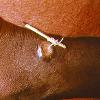

Dracunculiasis, also called guinea worm disease (GWD), is a parasitic (parasitism) infection caused by a long and very thin nematode (Dracunculus medinensis).rp437 The infection begins when a person drinks stagnant water contaminated with microscopic "water fleas" harboring the larvae of the guinea worm. Approximately one year later, the disease presents with a painful, burning sensation as the worm forms a blister, usually on the lower limb. Once prevalent in 20 nations in Asia and Africa, the disease remains endemic (endemic (epidemiology)) in only four countries in Africa.
The guinea worm is one of the best historically documented human parasites, with tales of its behaviour reaching as far back as the second century BC in accounts penned by Greek chroniclers. The name dracunculiasis is derived from the Latin (Latin language) "affliction with little dragons" while the common name "guinea worm" appeared after Europeans first saw the disease on the Guinea coast of West Africa in the 17th century.
The Carter Center has predicted that guinea worm disease will be the first parasitic disease to be eradicated (disease eradication) and the first disease to be eradicated through behavior change, without the use of vaccines or a cure. There is no animal or environmental reservoir (natural reservoir) of D. medinensis and thus the parasite must pass through humans each year to survive.
Diseasesdb: 3945
Icd10: ICD10B72b65
Icd9: ICD9125.7
Emedicinesubj: ped
Emedicinetopic: 616
Meshid: D004320

